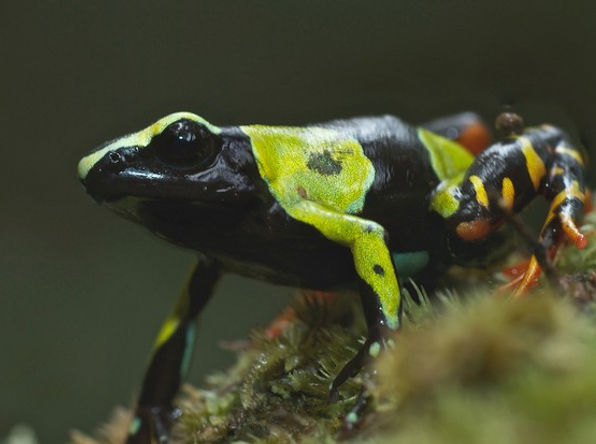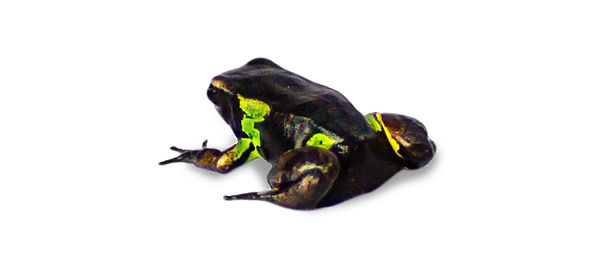5- Mantella pulchra - The beautiful mantella
Parker, 1925
From Wikipedia, the free encyclopedia
The beautiful mantella, Parker's mantella, or splendid mantella (Mantella pulchra) is a species of frog in the Mantellidae family. It is endemic to Madagascar. Its natural habitats are subtropical or tropical moist lowland forests, subtropical or tropical swamps, and swamps. It is threatened by habitat loss. It may be threatened by the pet trade, but to little is known about commercial collection.





Beautiful mantella
Conservation status :
Near Threatened (IUCN 3.1)[1]
Scientific classification :
Kingdom:Animalia
Phylum:Chordata
Class:Amphibia
Order:Anura
Family:Mantellidae
Genus:Mantella
Species:M. pulchra
Binomial name:
Mantella pulchra
Parker, 1925


Video :
Mantella pulchra
For the external links , refrences click here to read the full wikipedia article
Care articles :
1- Beautiful Mantella - Mantella pulchra
courtesy : www.joshsfrogs.com/beautiful-mantella-captive-bred-mantella-pulchra-for-sale.
Defining Characteristics: Great beginner Frog | Bright Beautiful and orange Coloration develops as Mantella ages | Bold | Easy to Keep | Moderate Trilling Call | Small | Can be kept in groups | Challenging to Breed
Name: Mantella pulchra is commonly called the beautiful mantella in the hobby.
Recommended Vivarium Size: Housing beautiful mantellas can be very simple. A 10 gallon aquarium can house a couple individuals, while an Exo Terra Glass Terrarium with a footprint of 18x18 or larger could house 4-6 Beautiful mantellas. Beautiful mantellas seem to be completely passive towards each other for the most part (outside the breeding season), and do great in groups. A screen top with daily mistings will maintain the perfect balance of ventilation and humidity. Substrate recommendations vary considerably, but long fiber sphagnum moss works well for Josh’s Frogs. Alternatively, you can set up a vivarium using Josh’s Frogs naturalistic vivarium substrates, similar to keeping dart frogs. Provide items for your Beautiful mantellas to hide under, such as a cork bark flat or leaf litter. Your Mantella pulchra will spend much of the time hiding under such objects. A shallow water bowl should be provided, as well. Beautiful mantellas are not particularly arboreal, but they will appreciate a small bit of vivarium wood or live terrarium plants to climb on. Lighting is for any live plants provided, and not required by Beautiful mantellas. There is no evidence that Mantella pulchra benefit from UVB lighting, but a low level UV bulb, such as a 2.0 UVB bulb, may be beneficial. Based on observations of Beautiful mantellas being active during the day in the wild in partiall sunlight, a low level UVB source would probably be a good idea.
Temperature: Mantella pulchra ideally are kept at about room temperature, in the low to mid 70s. Avoid warmer temperatures over 80F at all cost.
Humidity: Beautiful mantellas can handle a wide range of humidity levels, but prefer a humidity level of 60-70%. Routine spraying and a full screen top will aid in providing proper humidity levels. Be sure to provide a shallow water dish so that your Beautiful mantellas will not dry out in lower humidity. During the breeding season, Beautiful mantellas can experience humidty levels of 80% without issue.
Size: Adult Beautiful mantellas are not very large, and there is a small size different between males and females. An adult male may reach about 1 inch, but most will be closer to 3/4 of an inch. A large female will be a bit larger and much bulkier (or 'pear shaped') than a male, and may measure up to 1”. All of the Mantella pulchra froglets Josh's Frogs sells are well started juveniles, and measure approximately .5” long.
Age: There is not any good data surrounding the average lifespan of Beautiful mantellas, but wild caught animals have lived in captivity for over 5 years. All Beautiful Mantellas for sale at Josh's Frogs are well started juveniles, and are 2-3 months old. Keep in mind, at this age froglets will have very different color and patterns than they will as adults.
Feeding: Beautiful mantellas are microphagus, meaning that they consume small food items. Mantella pulchra do quite well on easily procured prey items in captivity. At Josh’s Frogs, we feed our adult Beautiful mantellas primarily hydei fruit flies, as well as springtails, isopods, extra small phoenix worms, and 1/8 inch crickets. Young Beautiful mantellas start life feeding on baby springtails. At the size Josh’s Frogs sells captive bred Mantella pulchra, they are eating melanogaster fruit flies and 1/8" crickets. All prey items should be dusted with a quality vitamin/mineral supplement.
Sexing: Sexing adult Beautiful mantellas can be fairly straightforward once they're older, but can be difficult on younger animals. Once the mantellas are about 10-12 months old, they display obvious sexual dimorphism. Females are about 1/5 times larger then males, and much more rotund. Males are smaller, more slender, and typically call when kept in a wet or more humid environment. Reportedly, male Beautiful mantellas tend to be more skittish than females. A Beautiful mantella’s call resembles that of a canary, and is very melodious.
Color/Pattern: Adult Beautiful mantellas are primarily dark brown with green and a bit of orange flash marks. The young animals will brighten up as they grow. Expect your beautiful mantellas to be fully colored up at 8-12 months of age.
Social Behavior: Beautiful mantellas are generally well behaved in groups, but adult females can fight with each other during breeding season. Keeping a group in a large enough vivarium with plenty of visual barriers tends to negate this behavior. Overall, Mantella pulchra is a great group frog.
Breeding: Breeding Beautiful Mantellas can be a bit challenging. In our experience, patience is key, as is a decent sized group that is female heavy. Cycling is important. We reduced mistings by half to allow the mantella habitat to dry out a bit, ensuring clean water was always available to the animals in a shallow water dish during this time. Feeding was reduced by about half as well. This artificial dry season was maintained for 3-4 months, followed by a 6 month return to daily misting and heavy feeding. Within a few days of more frequent mistings, the male could be heard calling. Less than 2 weeks into the artificial rainy season, an egg clutch of approximately 20 eggs was discovered under a piece of cork, buried about 1" into the long fiber sphagnum moss substrate. Eggs are removed and kept on damp sphagnum until they hatch and small, white/gray tadpoles are seen squirming through the egg jelly. Water is then added to the container, flooding the egg clutch and allowing the tadpoles to swin free. After a few days, the tadpoles are removed with a turkey baster and placed in an aged 20H aquarium with undergravel and sponge filters. At 74F, Beautiful mantella tadpoles will eagerly consume a wide variety of foods, from brine shrimp flake to Repashy Savory Stew. After 6-8 weeks, they will develop limbs and begin to leave the water. Newly morphed Beautiful mantellas will quickly consume springtails and grow very fast.
Natural Range: Mantella pulchra is limited to a fairly limited strip of jungle along the east coast of Madagascar. In the wild, it can be found in very limited localities in dry forest, generally around gently flowing streams with plenty of cover along the banks. With the natural range of Beautiful mantellas so limited, habitat destruction is quickly reducing their numbers in the wild. They are classified as vulnerable by the IUCN.
History in the Hobby: Beautiful mantellas have been available as wild caught animals for a long time, but captive bred animals remain rare. Unfortunately, most imports were doomed in captivity due to primative importation and shipping methods, as well as a lack of general knowledge surrounding their care.





2- Beautiful Mantella - Mantella pulchra :
courtesy to : mantella.amphibiancare.com/species/mantella_pulchra

Description: Somewhat variable in terms of pattern, Mantella pulchra often appears similar to M. madagascariensis but with tan or brown limbs. In addition, the black or dark brown color of their head usually fades to a light tan as it approaches the rostral stripe. Green blotches are present at the insertion of the limbs. Frogs with blue blotches also exist, though these may just be a naturally occurring mutation rather than typical of M. pulcra from a certain region. The larger females are capable of reaching 25 mm (1.0 inches), while males stay smaller and are less robust in shape.
Red List Conservation Status: Vulnerable
Distribution and Habitat: M. pulchra occurs in rainforest in east-central Madagascar. It is reported to occur sympatrically with M. baroni in some locations.
Captive Care Notes: Often exported, M. pulchra makes regular appearances in the North American pet trade. They are sometimes misidentified and sold as or along with M. madagascariensis, but can be told apart by the brown color on their limbs. Captive breeding has occurred, but not often, and captive-bred frogs are rarely available. M. pulchra is relatively shy, spending much of the time hidden when food is unavailable. It may be helpful to provide plenty of cover so that they feel secure, increasing the likeliness that they will come out so they can be observed. A temperature a range from 19°C to 25°C (66°F to 77°F) works well for captive M. pulchra. During a simulated dry season, the temperature can fall as low as 15°C (59°F) without problems.
References :
Staniszewski, Marc. Mantellas. 1st ed. Frankfurt: Chimaira, 2001. 204-207.
Vences, M., F. Glaw & W. Böhme. 1999. A review of the genus Mantella (Anura, Ranidae, Mantellinae): taxonomy, distribution and conservation of Malagasy poison frogs. Alytes 17 (1-2): 3-72.
Madagascar Dart frogs
Aromobatidae :
-
Allobatinae
-
Anomaloglossinae
-
Aromobatinae
South America Dart Frogs - Species
Dendrobatidae :
-
Colostethinae
-
Dendrobatinae
-
Hyloxalinae
Madagascar Dart frogs :
Mantella : Introduction .. Further reading , Videos and as a pet
Species :
1- Mantella aurantiaca - golden mantella : Part 1 .. Part 2
2- Mantella baroni : Part 1 .. Part 2
3- Mantella laevigata : Part 1 .. Part 2
5- Mantella pulchra : Part 1 .. Part 2
7- Mantella Other species : PART ONE .. PART TWO
Madagascar Dart frogs :
Mantella : Introduction .. Further reading , Videos and as a pet
Species :
1- Mantella aurantiaca - golden mantella : Part 1 .. Part 2
2- Mantella baroni : Part 1 .. Part 2
3- Mantella laevigata : Part 1 .. Part 2
5- Mantella pulchra : Part 1 .. Part 2
7- Mantella Other species : PART ONE .. PART TWO